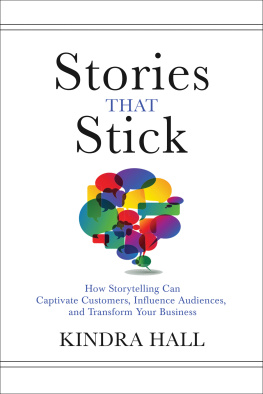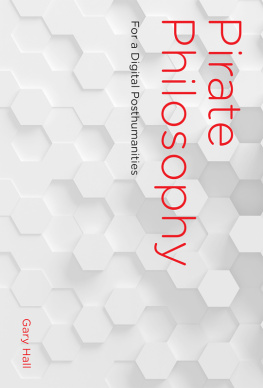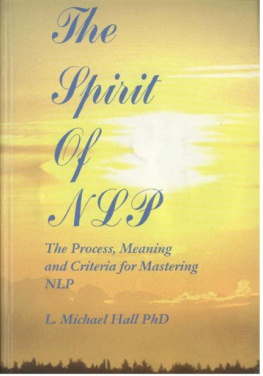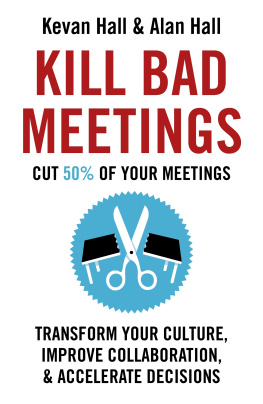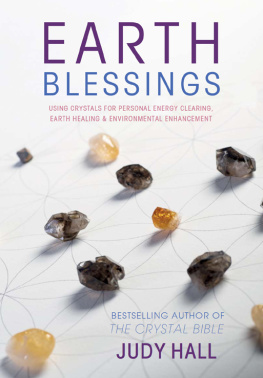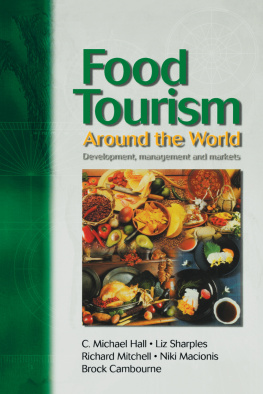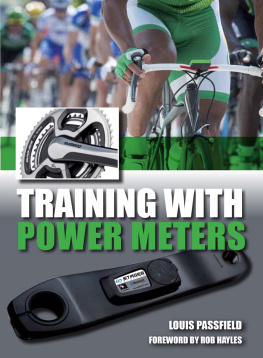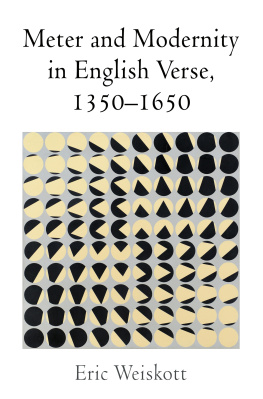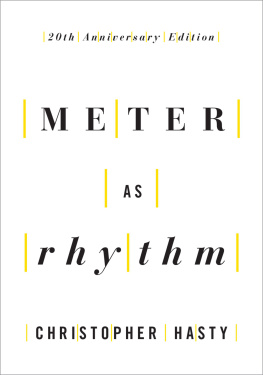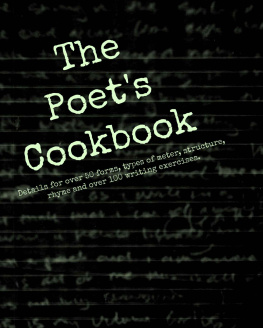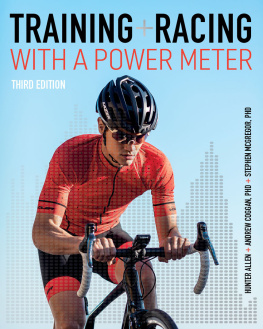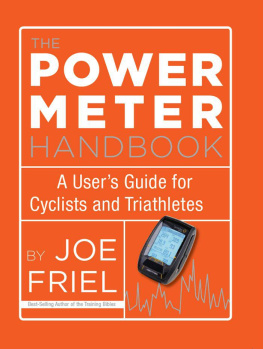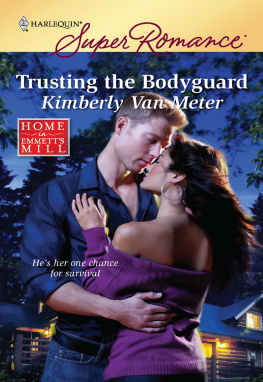meter matters
Verse Cultures of the Long Nineteenth Century
EDITED BY JASON DAVID HALL

Ohio University Press, Athens, Ohio 45701
ohioswallow.com
2011 by Ohio University Press
All rights reserved
To obtain permission to quote, reprint, or otherwise reproduce or distribute material from Ohio University Press publications, please contact our rights and permissions department at (740) 593-1154 or (740) 593-4536 (fax).
Printed in the United States of America
Ohio University Press books are printed on acid-free paper 
20 19 18 17 16 15 14 13 12 11 5 4 3 2 1
Library of Congress Cataloging-in-Publication Data
Meter matters : verse cultures of the long nineteenth century / edited by Jason David Hall.
p. cm.
Includes bibliographical references and index.
ISBN 978-0-8214-1968-7 (hc : alk. paper)
1. English languageVersification. 2. English languageRhythm. 3. English poetry19th centuryHistory and criticismTheory, etc. I. Hall, Jason David, 1975
PE1505.M485 2011
821'.809dc23
2011031205
Contents
JASON DAVID HALL |
ISOBEL ARMSTRONG |
SUSAN J. WOLFSON |
MATTHEW BEVIS |
YOPIE PRINS |
JASON R. RUDY |
SUMMER J. STAR |
YISRAEL LEVIN |
MICHAEL COHEN |
CORNELIA PEARSALL |
MEREDITH MARTIN |
Illustrations
Preface
The contributors to Meter Matters have new things to tell us about a roughly hundred-year period during which writing in meter and theories about it proliferated. Their essays showcase not only the diversity of nineteenth-century metrical practice but also the richness of twenty-first-century metrical scholarship. In particular, this compilation emphasizes the imperative to contextualize and historicize versificationa defining feature of much recent critical work on Romantic and Victorian meters. The chapters in this volume explicate for us the particularity and peculiarity of nineteenth-century metrical discourse, its multiple sounds and settings, and the plurality of its timings and taxonomies. Some of the discussed terms and topics may be unfamiliar to readers, particularly those of us trained in the vocabulary of accentual-syllabic prosody, the default metrics in English departments for much of the twentieth century. The metrical matters scrutinized here do not necessarily take syllables, accents, and feet as their starting pointindeed, the foot was, for many of the poets and metrists discussed below, a contested unit of measurement, not a prosodic given. No single definition of meter or system for representing its patterns accounts for the multiplicity of nineteenth-century prosody. In fact, a competition among patterns and systemsa dialectic processmay be what distinguishes the meters surveyed in the books introduction and the ten chapters that follow.
Constitutive oppositions and tensions are very much central to the prosodies that Isobel Armstrong examines in major Romantic and Victorian poetry and poetic theory (Armstrong takes us from Hegelian prosody to Patmores metrical law, offering close readings of Wordsworths The Solitary Reaper and Tennysons Break, Break, Break to flesh out her argument) but may also be a fundamental impulse of nineteenth-century modernity. Readers familiar with Armstrongs important study Victorian Poetry (1993) will no doubt hear echoes of her analysis of the double poem. The doubleness, or irreducible plurality, of meter may challenge us to rethink our hermeneutic praxis.
At the start of her chapter, Armstrong asks: what is the relationship between the nonsemantic sounds of meter and the poems cognitive content? Like Armstrong, Susan Wolfson, whose contextualized formalism clearly subtends much of the work on display in Meter Matters, is interested in the sounding of meter; her analysis, however, takes a somewhat different sonic tack, moving across a virtual sea of Romantic verse where sound effects and semantics coalesce. Looking closely at events that make meaning with metrical stress on words of sound and sounding, Wolfson explores the materiality of meter stresses as figured in poems by Wordsworth, Coleridge, Southey, Byron, Shelley, and Keats. Sound, she shows, can take both sublime and playful forms. Whether harmonious, as sometimes in Shelleys thinking, or disruptive, sound (which can include voicing but also silence) takes on structural importance beyond the merely musical. As Wolfson remarks, When meter stresses sound, it figures the forming of poetry itself. This chapter is a tour de force of Romantic acoustics.
In , Matthew Bevis extends the previous chapters direct engagement with the materiality of meter. Byrons Feet, which scrutinizes Romantic attitudes (and implicitly our own) toward meters relationship with the body, reminds us that the poets distinctive gaitin verse as in lifewas a preoccupation not only for the self-conscious poet, for whom it formed part of a poetics of concealment and revelation, but also for his critics and readers. The body of Byrons verse, ostensibly on display and available for ready explication, is not as easy to decipher as it might at first appear. Pinning down how the poet moves in meter asks us to reconsider our own received thinking about what nimbleness and deliberateness in versification (as in life) may actually signify. In a reading that is fully attuned to the conjunction of the physical, the prosodic, and the political, Bevis argues that there is no such thing as the perfectly regular, undeviating line, for meter is an approximation, a fiction of regularity imposed on bodies of verse.
The next chapter, by Yopie Prins, whose exemplary work on historical prosody was one of the inspirations behind Meter Matters, extends the books emphasis on nineteenth-century meters multiform character. Reconsidering the attention to sound in Armstrongs and Wolfsons chapters, the chapter by Prins encourages us to think about the imagination of sound produced by theories of meter during the middle and late years of the Victorian period. There was a resurgence of interest in the relationship between music and meter in nineteenth-century metrical treatises that developed musical notation as an alternative to more familiar foot-based approaches to English meter. In dialogue with Armstrongs reading of Tennysons Break, Break, Break, Prins shows how the poem was taken up by various musical metrists (including John Ruskin, William Thomson, Sidney Lanier, and Julia Dabney) and in numerous musical settings (including songs composed by Sidney Lanier, George Henschel, and William R. Dempster). In different ways, each example imagines the sound of a voice that cannot be heard, thus complicating our narrative about how meter was represented in the nineteenth century, and how sound and print function in the process of bringing poems to the readers ears and eyes. By allowing us to see (if not exactly hear) these idiosyncratic interpretations of Tennysonian metrics, Prins suggests how we might go about historiciz[ing] modes of musical thinking that are different from our own.
, by Jason R. Rudy, extends the volumes thinking about meter and embodiment. It takes Coventry Patmore as its focus, participating in a scholarly reassessment of Patmores work in and on verse. Reading Patmores well-known paean to domestic femininity,
Next page

